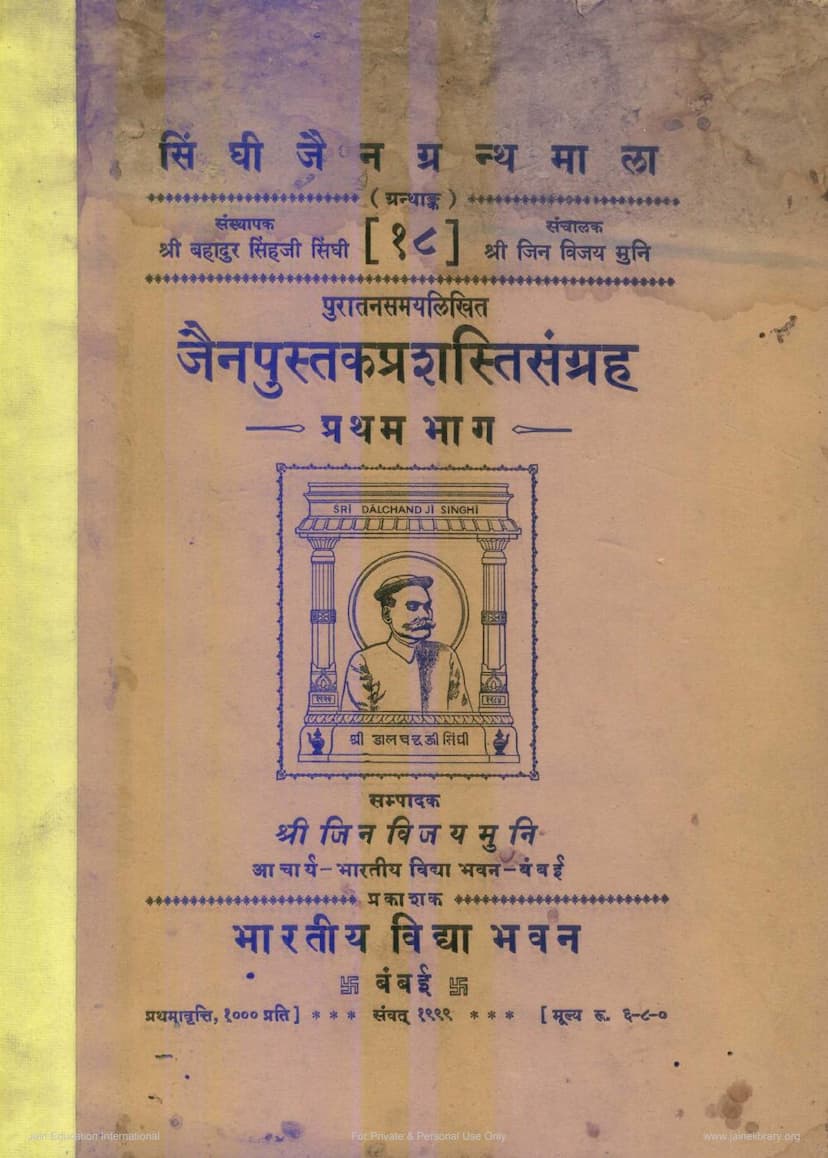Jain Pustak Prashasti Sangraha 1
Added to library: September 2, 2025
Loading image...

Summary
This Jain text, titled "Jaina Pustaka Prashasti Sangraha" (A Collection of Praśastis and Colophons of Ancient Manuscripts), is the first part of a multi-volume series.
Key points from the provided pages:
- Purpose: The book is a collection of "prakāśati" (authoritative statements) and "puṣpikālekha" (colophons or concluding remarks) found at the end of ancient Jain manuscripts. These inscriptions are valuable for understanding the history, lineage, time periods, patrons, and scribes associated with these manuscripts.
- Establishment of the Singhi Jain Granthamala: The series is dedicated to the sacred memory of Seth Shri Dalchandji Singhi of Calcutta, a saint-like individual. It was established and published by his devoted son, Shriman Bahadur Singhji Singhi, who was a prominent figure in Jain society, a patron of literature, and a culture enthusiast.
- Editorial Guidance: The project is directed and generally edited by Shri Jina Vijaya Muni, an Acharya of Bharatiya Vidya Bhavan, Mumbai. He is a respected scholar with extensive experience in editing and researching ancient Jain and other Indian literary works in various languages like Prakrit, Sanskrit, Apabhramsa, and Old Rajasthani-Gujarati. Shri Rajendra Singhji Singhi provides notable guidance.
- Content of the Series: The Singhi Jain Series aims to publish critical editions of important Jain canonical, philosophical, historical, literary, narrative, and other works. It includes texts in Prakrit, Sanskrit, Apabhramsa, and Old Rajasthani-Gujarati languages, as well as new research by competent scholars.
- This Volume (Part 1): This first part specifically contains inscriptions found within ancient palm-leaf manuscripts. These manuscripts are preserved in Jain Bhandaras (libraries) located in places like Patan, Cambay, and Jaisalmer.
- Significance of Praśastis/Colophons: The text highlights the immense historical and evidential value of these inscriptions. They are considered as important as temple inscriptions or royal land grants (tamrapatras) for reconstructing the ancient history of the land, society, and religion. They provide details about:
- The donors (wealthy individuals, patrons) who commissioned the writing of these manuscripts.
- Their ancestors, families, lineages, and communities.
- The time and place of the manuscript's creation.
- The authors (gurus, ācāryas) and their traditions.
- The scribes (lipikars) who meticulously copied the texts.
- Contemporary rulers and officials.
- The devotional spirit and philanthropic activities within the Jain community for the propagation of knowledge.
- Types of Praśastis: The collection includes two main types of inscriptions:
- Grantha Prashasti: Longer, often poetic descriptions related to the author and the text itself.
- Sankshipt Pushpika Lekh: Shorter, often prose-based concluding remarks that usually contain details about the scribe, date, and donor.
- Dedication: The publication is in loving memory of the late Seth Shri Dalchandji Singhi.
- Publication Details: The first edition was published in Samvat 1999 (1943 AD) in 1000 copies. The price was Rs. 6-8-0. The publisher is Bharatiya Vidya Bhavan, Mumbai.
- Dedication to Mata Motibai: A personal dedication is made to Mata Motibai, acknowledging her contribution to the author's life and spiritual journey.
In essence, this book is a foundational scholarly work for anyone interested in the history of Jain literature, manuscripts, and the socio-religious patronage that supported the preservation and dissemination of Jain knowledge through the ages. It serves as a primary source for historical research due to the detailed information contained within the colophons and inscriptions.